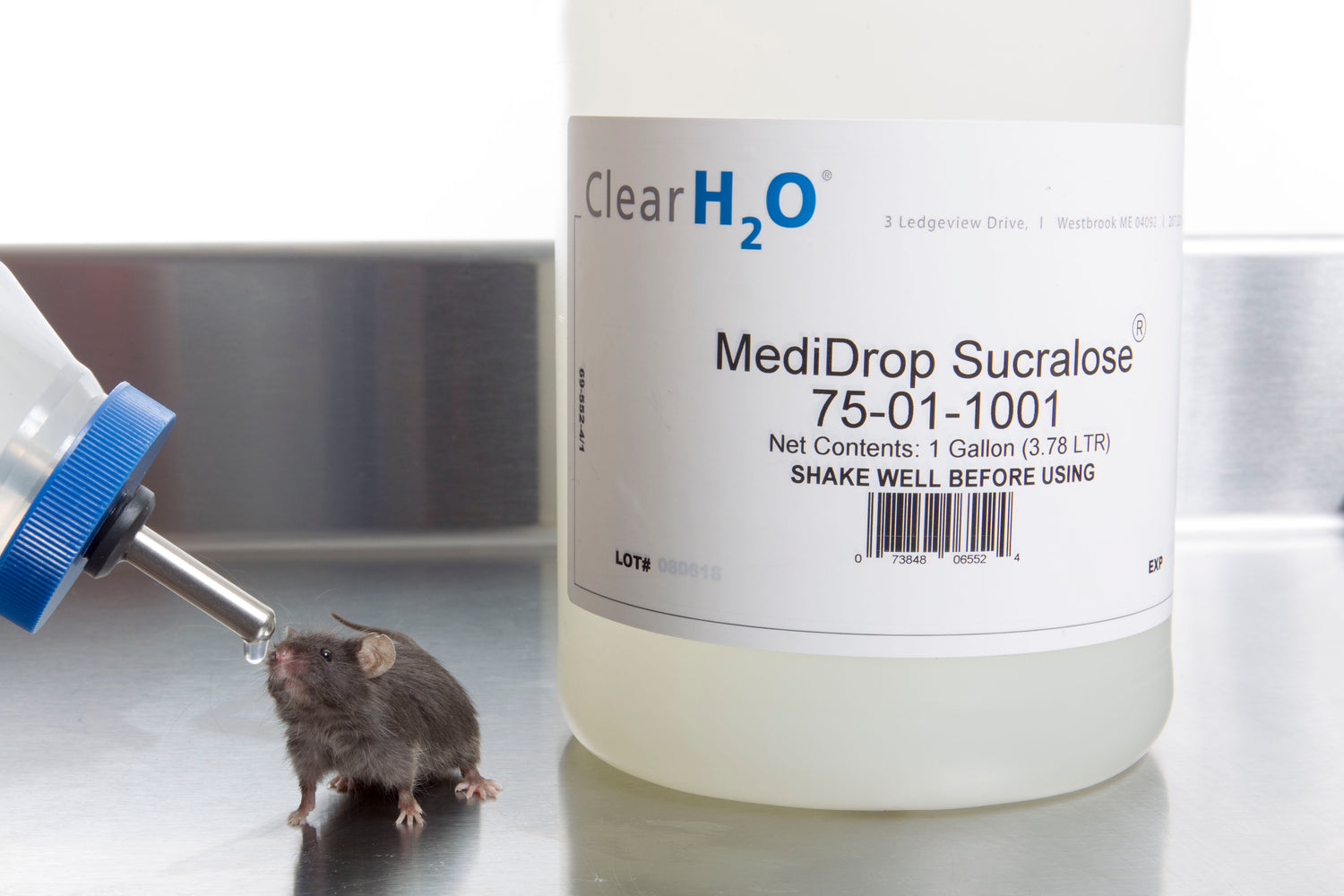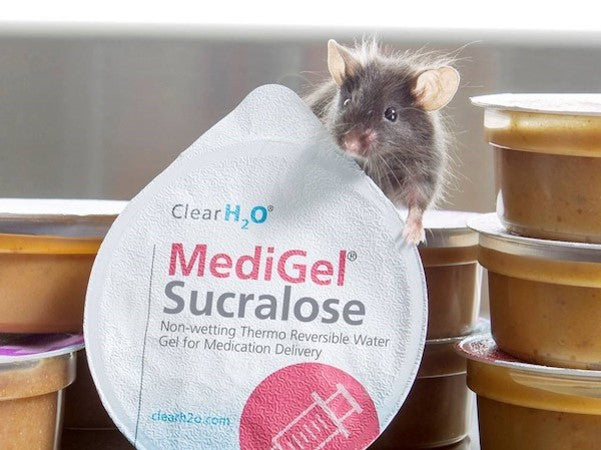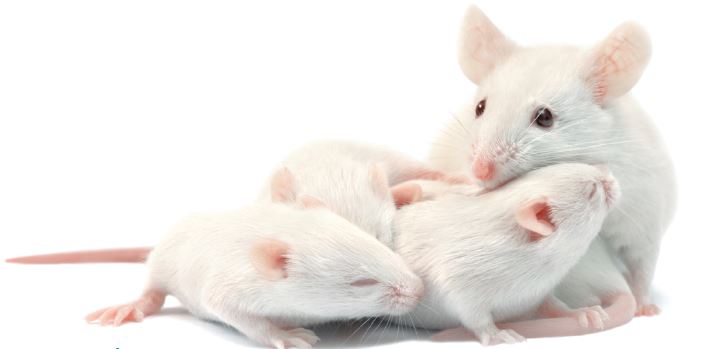The well-being and health status of research mice is a top priority for experimental results and reproduction of data. The use of antibiotics and antiparasitics is a standard of care in veterinary medicine. They are used in laboratory animals to treat clinical diseases and protect populations that may be vulnerable to infections.
Oral administration of medication is an efficient alternative mode of delivery and is preferable for several reasons, including low stress to the animal and time efficiency for researchers and other laboratory personnel. However, some drugs can precipitate out when added to water, may be unstable and consumption can be low due to the undesirable taste of those medications. This is especially true for drugs such as Bactrim® (sulfamethoxazole/trimethoprim) which can settle to the bottom of a water bottle. Daily shaking is required to re-suspend the drug to ensure rodents are consuming a consistent, therapeutic dose.
The two studies below show that MediDrop® Sucralose, a sweetened water gel formulation, maintains medications in suspension and facilitates consistent delivery.
The City of Hope in California tested the stability of trimethoprim (TMP)-sulfamethoxazole (SMX) in 3 different conditions through the standard water bottle:
Water bottles filled with these solutions and accompanying medications were positioned in empty mouse cages. Samples from the solutions were then collected at 0, 4h, 8h, 24h, 48h, 72h and 7 day time points to mimic the water the mice would be drinking from the end of the sipper tube. Analysis of drug concentration was conducted using High-performance liquid chromatography (HPLC).
The concentration of Trimethoprim remained stable in all three groups. Sulfamethoxazole precipitated out of the RO and AW groups; however, it remained in suspension in the MediDrop® Sucralose group.
In parallel, in vivo results (graph below) show that mice on MediDrop® Sucralose administration had significantly higher blood concentrations of both trimethoprim and sulfamethoxazole at days 3 and 5 compared to the RO and AW groups. This data demonstrates that MediDrop® Sucralose delivers a higher and more consistent therapeutic dose of both drugs.

In order to compare MediDrop® Sucralose and water as orally-administered vehicles in traditional water bottles for commonly used drugs in mouse medicine, The University of California San Francisco tested 4 different drugs, administered to C57BL6 mice in water or MediDrop® Sucralose after acclimation for 72h:
The MediDrop® Sucralose bottles were shaken once to mix in the respective medications and then left alone, whereas the regular water bottles with medication were shaken daily in order to keep the drugs in suspension. Blood was collected from all groups via the submandibular method at days 1, 3 and 7 days after the start of drug administration, and blood drug concentration levels were determined.
Results (graph below) show that plasma levels were higher for some or all time points for all drugs in mice receiving the drug in MediDrop® Sucralose compared to those receiving the drug in water. MediDrop® Sucralose was determined to be a superior delivery method to water.

To try MediDrop® Sucralose, request a sample! Learn more about our other medication delivery products on our MediGel® Sucralose blog and MediGel® Hazelnut blog.
- Pinworm outbreaks are a relatively common occurrence in research facilities and can be eradicated with commercially available anti-parasitic drugs, such as fenbendazole and ivermectin.
- Skin conditions (dermatitis and traumatic wounds from fighting) and ocular lesions are the most common clinical conditions in mouse colonies and can be treated with antibiotics.
- When surgeries are performed, antibiotic administration is also desired. Similarly, extensive traumatic lesions and generalized infections, especially those in immunocompromised animals, warrant systemic antibiotics.
Oral administration of medication is an efficient alternative mode of delivery and is preferable for several reasons, including low stress to the animal and time efficiency for researchers and other laboratory personnel. However, some drugs can precipitate out when added to water, may be unstable and consumption can be low due to the undesirable taste of those medications. This is especially true for drugs such as Bactrim® (sulfamethoxazole/trimethoprim) which can settle to the bottom of a water bottle. Daily shaking is required to re-suspend the drug to ensure rodents are consuming a consistent, therapeutic dose.
The two studies below show that MediDrop® Sucralose, a sweetened water gel formulation, maintains medications in suspension and facilitates consistent delivery.
TMS concentration is steady in MediDrop® Sucralose
The City of Hope in California tested the stability of trimethoprim (TMP)-sulfamethoxazole (SMX) in 3 different conditions through the standard water bottle:
- Reverse Osmosis water
- Acidified Water
- MediDrop Sucralose
Water bottles filled with these solutions and accompanying medications were positioned in empty mouse cages. Samples from the solutions were then collected at 0, 4h, 8h, 24h, 48h, 72h and 7 day time points to mimic the water the mice would be drinking from the end of the sipper tube. Analysis of drug concentration was conducted using High-performance liquid chromatography (HPLC).
The concentration of Trimethoprim remained stable in all three groups. Sulfamethoxazole precipitated out of the RO and AW groups; however, it remained in suspension in the MediDrop® Sucralose group.
In parallel, in vivo results (graph below) show that mice on MediDrop® Sucralose administration had significantly higher blood concentrations of both trimethoprim and sulfamethoxazole at days 3 and 5 compared to the RO and AW groups. This data demonstrates that MediDrop® Sucralose delivers a higher and more consistent therapeutic dose of both drugs.

TMS achieves higher plasma levels in MediDrop® Sucralose
In order to compare MediDrop® Sucralose and water as orally-administered vehicles in traditional water bottles for commonly used drugs in mouse medicine, The University of California San Francisco tested 4 different drugs, administered to C57BL6 mice in water or MediDrop® Sucralose after acclimation for 72h:
- TMS
- Meloxicam
- Ibuprofen
- Enrofloxacin (Baytril)
The MediDrop® Sucralose bottles were shaken once to mix in the respective medications and then left alone, whereas the regular water bottles with medication were shaken daily in order to keep the drugs in suspension. Blood was collected from all groups via the submandibular method at days 1, 3 and 7 days after the start of drug administration, and blood drug concentration levels were determined.
Results (graph below) show that plasma levels were higher for some or all time points for all drugs in mice receiving the drug in MediDrop® Sucralose compared to those receiving the drug in water. MediDrop® Sucralose was determined to be a superior delivery method to water.

To try MediDrop® Sucralose, request a sample! Learn more about our other medication delivery products on our MediGel® Sucralose blog and MediGel® Hazelnut blog.




Leave a comment
All comments are moderated before being published.
This site is protected by hCaptcha and the hCaptcha Privacy Policy and Terms of Service apply.